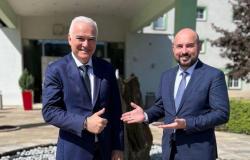You can also listen to the article in audio version.
František Filip was born in 1904 in Jamné nad Orlicí. He was born without upper limbs. It is said that the neighbors advised the mother to do what was necessary. “… as it is done with kittens that are still blind. Drown while the creature still doesn’t understand, doesn’t perceive anything, just screams and screams… Drown it…”
The author of this text does not dare to estimate to what extent this was common practice in similar cases at the beginning of the 20th century and whether the disappearance of a newborn would not have attracted the attention of the authorities. In any case, care for the handicapped was still in its poor beginnings. And it was practically unaffordable for poor rural people.
But “Armless Frantík” was lucky. The mother did not give him away, she decided to risk even greater poverty by feeding an “extra child” who would never earn any money on her own.
And František was doubly lucky. In 1913, he became one of the first clients of Prague’s Jedlička Institute.
What about them
Historians disagree on how common practice the killing of disabled children was in ancient Greece and Rome. The common image of “cripples” being thrown off a cliff in Sparta is more of a myth than an evidence-supported statement about society at the time. However, the life of people with some types of disabilities did not come at a high price.
It had both pragmatic and ideological reasons. A disabled person was usually unable to take care of himself, he was a burden on the family and society. And death, exile, or beggary often awaited such a person.
And then there was the belief that soul and body are harmoniously connected. That the deformation of the body points to the deformation of the soul. However, this connection could also create desirable comic combinations – the handicapped were a popular attraction at the Roman imperial court as jesters. And some wealthy Roman women kept significantly deformed children as pets.
In an important respect, they were similarly handicapped in the Middle Ages. In the Bible, you can find quotes that connect physical disabilities with sin. But there are also passages of miraculous healing. In the Christian medieval world, people feared the disabled, despised them, killed them, abandoned them, expelled them, burned them as witches… And they also tried to cure them, or rather save them. In monasteries, exorcism, laying on of hands, prayer…
In the 18th and 19th centuries, hospitals, institutions, and almshouses began to increase. But they often resembled prisons.
Even at the end of the eighteenth century in Paris, a visit to an asylum was one of the festive outings of a middle-class family. At that time, the insane were interned in institutions together with beggars or the sick. They lay on straw in tight dungeons. “When the Seine flooded in the winter, these cells, lying at the level of the canals, became not only even more unhealthy, but in addition a whole crowd of large rats ran to hide in them, which at night pounced on the unfortunates shut up there and bit them wherever they went. they just got,” Michel Foucault quotes in The History of Madness from the Report on the Care of the Insane, dealing with the situation at the end of the eighteenth century.
With the enrichment of society and the progress of medicine, the care of the handicapped begins to radically change and improve only from the second half of the 19th century. But that progress is not without risk. For the handicapped, a new deadly enemy is emerging – eugenics. (More about eugenics in the infobox below).
The Wannsee Conference
The Jews must be exterminated. As quickly as possible, as efficiently as possible. This was the topic of the Wannsee conference on January 20, 1942. The conference was also quick and efficient. Fifteen soldiers, politicians and officials drew the outlines of the Holocaust in an hour and a half.
From almshouses to a top institute
The society of the 18th and 19th centuries – to put it simply – had neither the interest, nor the knowledge, nor the experts, nor the money to provide the disabled with the necessary health and social care.
A typical institution that cared for outcasts from “normal” society was the workhouse. Manorial, municipal, exceptionally also state. They were supposed to ensure that sick, abandoned children, beggars, vagrants, disabled people did not die on the street, did not obstruct, did not provoke… It was not about treating them or teaching them something.
So the idea of an institution that would provide professional care and education to disabled children, in the parlance of the time, “cripples”, was revolutionary. The founding personality was the doctor Jan Dvořák, who in 1908 initiated the creation of the “association for the treatment of rickets and cripples”.
He conceived the project in a modern way: Children will be treated, rehabilitated, educated, and if possible, prepared for an independent life. Ideally in cooperation with the family. In 1911, another modern-thinking doctor and experimenter, Rudolf Jedlička, became the chairman of the association.
Photo: CTK
Just one comment about Jedliček’s visionary work. In 1895, Carl Roentgen published a report on the discovery of new rays, which he called X-rays. Already a year later, Jedlička was the first in the monarchy to have a Roentgen device.
Back then, it still had not only innovative, but also bizarre elements. The first “roentgen” was located in the U Černého koné hotel in Prague. The owner of the hotel helped Jedlička financially with the purchase of the device. And since people still had no idea about the harmfulness of “X-rays”, they looked at their bones while waiting for lunch.
Jedlička himself later lost several fingers because he regularly tested the correct setting of the device on the image of his own hand.
More importantly, based on the cooperation of two doctors – the visionaries Dvořák and Jedlička, the path to building a modern institution for handicapped children was definitively opened.
The Jedličk Institute was founded on April 1, 1913.
Rudolf Jedlička (1869–1926)

Photo: Michal Klajban
.
- Rudolf Jedlička’s father was a respected doctor, also a kind of visionary – he advocated vaccination against smallpox at a time when the majority of doctors still did not approve of vaccination. The doctor also risked criminal penalties for complications after the vaccination.
- He graduated from the Czech academic high school in Prague and continued his studies at the Faculty of Medicine. He specialized in surgery. He graduated in 1895.
- As early as 1896, he was the first doctor in the monarchy to have a “Roentgen machine”. He first used it for diagnosis when he discovered a nail in a carpenter’s stomach. He swallowed it as he held it in his mouth while working with both hands.
- Jedlička was one of the pioneers of the use of “roentgen” and the introduction of radiology in the Czech lands.
- In 1908, Jedlička bought a neglected garden in Prague’s Podolí and founded an association to build a modern Prague sanatorium there. It was supposed to be a connection of cutting-edge research and modern treatment methods. He was inspired by a trip to the United States, where he visited the Mayo Clinic.
- Construction of the sanatorium began in 1911 and was completed three years later. At the time of the first republic, it was really a famous modern hospital and ambulance. Today, the Podol maternity hospital is located here.
- In 1911, he became the chairman of an association whose goal was to build an institution for handicapped children.
- In 1921, President Masaryk appointed Rudolf Jedlička a professor. He also became the first head of the newly established Second Surgical Clinic of Charles University.
- He died at the age of 57, he suffered from angina pectoris, the consequences of frequent radiation exposure, he was a heavy smoker.
- His motto: “It is not important for a person to live long, but for a person to be satisfied with his way of life and happy with his actions.” If this happiness of a person includes a bit of the happiness of others, then life is beautiful.”
On the top
Due to a lack of money, the beginnings were modest – the capacity of the institution was set at 10 children. But already in 1926, when the institute’s new modern building was opening, there were 131 clients.
Among the first children in Jedliček’s institution was František Filip, “armless Frantík”. Joined here December 3, 1913.
The teacher František Bakule, who was in charge of the pedagogical concept of the institute, wrote: “František Filip is an eleven-year-old boy, the son of workers, without arms from birth. In the circumstances in which he lived, he would surely have fallen only to begging, alcohol and vagrancy. He is our smartest inmate. He has already learned to provide for all his needs himself with his feet, and with various crafts he proves that what he has adopted as his motto – ‘I want, therefore I can!'” is not an empty phrase.
Bakule was another expert who confirmed the modern direction of the institute. Regardless of the nature of the disability, he wanted to teach and teach each client a trade, to lead them to independence. Children in the institute made toys, baskets, carpets… And the institute also founded its own production cooperative, where rehabilitation aids were created.
František Filip is an example that it made sense. He gave lectures in schools, ran a shop and a cafe, wrote a book, was married twice, had three children.
A medical miracle
Starve until you die. It will extend your life. This was the only effective treatment for diabetes. Then came the miracle: insulin. Live! The first patient with diabetes received insulin one hundred years ago – on January 11, 1922.

Debt
During the Second World War, the occupiers confiscated the institute’s buildings for their own infirmary. After 1948, the restored institute was nationalized by the Communists.
Lack of nurses, lack of doctors, lack of supplies. Children hardly ever get outside in the winter. Ain’t nobody got time for ’em. He crawls on the floor in the “worst equipped nursery”, a playroom that doubles as a bathroom…
Caring for the handicapped was not a priority for the communists. They treated them similarly to society in the 18th century – to remove them from the streets so that they do not disturb and spoil the impression. They are a burden, we are busy building a new company.
Handicapped people lived in a world behind ideological and quite concrete barriers. In theory, no one forbade them to freely move around the world, but practically they could not get almost anywhere. A small example: The only barrier-free station of the Prague metro was the Vyšehrad station for a long time. A wheelchair user could get on the subway, but not get off.
“We’ve built a monument to ruthlessness here, and it’s about time humanity stepped in. People who are lucky enough to be born healthy have no right to treat others as a burden. They have no right,” editor Libuše Hájková says at the end of the documentary Debt.
After 1989, Jedlička’s institute continued the project founded between the wars by Jan Dvořák, Rudolf Jedlička, František Bakule and other experts. He is trying to pay off the debt.
Eugenics
- Eugenics, simply put, is the belief that it is possible and necessary to improve the genetic make-up of the human population. In practice, eugenics represents multiple forms of persecution of the “inferior”. From forced sterilization to gas chambers.
- People associate “practical eugenics” primarily with Nazi Germany. But Hitler was inspired in the United States. Eugenic practices were widespread in many Western countries. And they were supported by important personalities. For example, Winston Churchill, who thought it could stop “racial deterioration” and help solve crime and poverty.
- In 1871, Charles Darwin wrote: “We civilized people build asylums for imbeciles, the crippled and the sick; and our paramedics are doing their best to save everyone’s lives until the last moment. (…) No one who has engaged in the breeding of domestic animals will doubt that it must be highly injurious to the human race.”
- The world was fascinated by the discoveries of Darwin and Mendel. Heredity was a new political and social issue. If we can breed plants and animals, why not humans? Isn’t that more important?
- The founder of eugenics was Darwin’s cousin, the British scientist Francis Galton. He stood at the beginning of a very influential movement that significantly influenced public discussion and politics in the late 19th and the first half of the 20th century.
- Eugenics in practice: Isolation of “imbeciles”, forced sterilization, isolation of the handicapped, gas chambers. Measures to “improve” the human population, a superior race. It’s like breeding domestic animals – a good breeder will not allow a two-headed calf to become the breeding male. And euthanizes a three-legged cripple.
- Eugenics in practice according to convinced promoters: State scientific commissions to decide whether a newborn with a handicap should be “culled”. And which will decide on “euthanasia” even for handicapped adults.
- “Soft eugenics” in practice – for example forced sterilization – has spread in the United States, but also in Denmark, Canada or Sweden, for example.
- “No person who is diseased, crippled, or in any way deformed so as to be an unsightly or hideous object or unfit person, shall enter the public ways or other public places in this city…,” a 1911 Chicago city code stated.
- The last “unsightly object” was imprisoned under this law in 1974.
- Eugenics does not give up.









